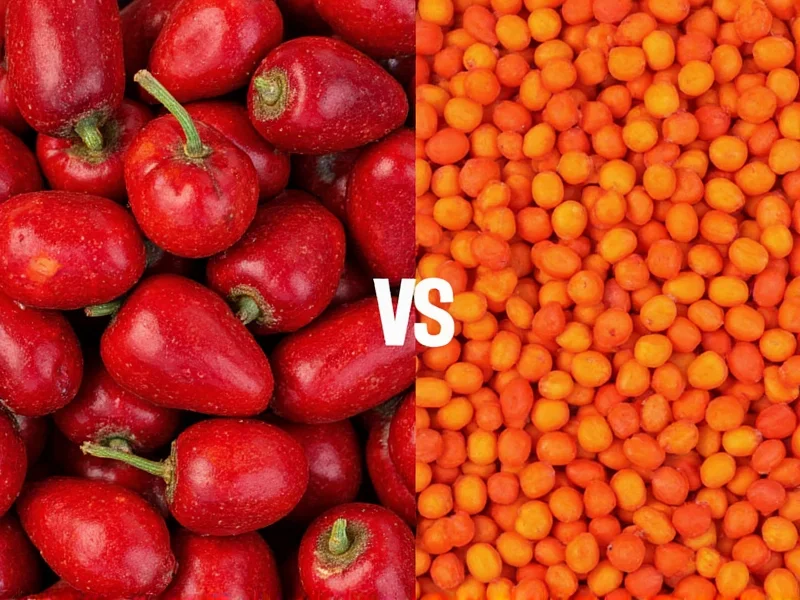Confusion between achiote vs annatto stems from regional naming conventions rather than botanical differences. This vibrant seed has colored and flavored dishes across continents for centuries, yet many home cooks wonder: are achiote and annatto different ingredients? Understanding this distinction—or lack thereof—helps cooks confidently use this versatile ingredient.
Origins of the Terminology
The Bixa orellana plant, native to tropical regions of the Americas, produces spiky red pods containing the prized seeds. Indigenous Caribbean peoples called it “achiot,” which Spanish colonizers adapted to “achiote.” English speakers later modified this to “annatto” or “annatto seed.” Despite the linguistic variations, food scientists and culinary professionals recognize them as identical.
Physical Forms and Culinary Applications
Chefs encounter this ingredient in multiple preparations, creating further confusion about achiote vs annatto:
| Form | Common Names | Primary Uses |
|---|---|---|
| Whole seeds | Annatto seeds, achiote seeds | Infusing oils, rice dishes, traditional recados |
| Ground powder | Achiote powder, annatto powder | Dry rubs, spice blends, coloring soups |
| Paste | Recado rojo, achiote paste | Marinating meats, especially in Yucatecan cuisine |
| Liquid extract | Annatto oil, achiote infusion | Coloring rice, cheeses, and processed foods |
Flavor Profile and Color Properties
Whether labeled achiote or annatto, the seeds impart a subtle, earthy flavor with hints of pepper and nutmeg. Their most valued characteristic remains the vibrant orange-red pigment (bixin), which provides natural coloring without significantly altering taste. This makes them ideal for:
- Coloring Latin American dishes like Venezuelan hallacas and Puerto Rican pasteles
- Creating the distinctive hue in British Red Leicester cheese
- Traditional Filipino achiote rice (sinangag)
- Caribbean meat marinades and stews
Substitution Guidance
When recipes specify achiote vs annatto, no substitution is needed—they're identical. However, if unavailable, consider these alternatives based on your need:
- For color only: Paprika (milder) or turmeric (different hue)
- For color and mild flavor: A blend of paprika and a pinch of cumin
- Traditional substitute: Safflower in some regional dishes
Remember that neither achiote nor annatto provides strong flavor, so substitutes focusing solely on taste miss their primary culinary function: natural coloring.
Nutritional and Safety Considerations
Both terms refer to a generally recognized as safe (GRAS) food coloring. The seeds contain antioxidants like bixin and norbixin, though most commercial applications use them primarily for color rather than nutrition. Some individuals report mild sensitivity, but serious reactions to achiote/annatto are rare compared to artificial colorings.
Global Usage Patterns
The terminology preference often follows regional patterns:
- Latin America: “Achiote” predominates in Spanish-speaking countries
- United States: “Annatto” appears more frequently on ingredient labels
- Philippines: “Achuete” (Tagalog adaptation) is standard
- Europe: “Annatto” or “CI 75120” (food additive code) is common
This explains why American cookbooks might specify “annatto seeds” while Mexican markets label the same product as “semillas de achiote.” Understanding these naming conventions prevents unnecessary substitutions when following international recipes.
Practical Cooking Tips
Maximize your use of this versatile ingredient with these evidence-based techniques:
- For even coloring: Bloom whole seeds in hot oil before adding other ingredients
- To prevent bitterness: Avoid overheating—the pigment degrades above 175°C (350°F)
- Storage: Keep in airtight containers away from light to preserve color potency
- Measurement: 1 teaspoon achiote powder colors approximately 4 cups of rice
Whether you call it achiote vs annatto, this ancient coloring agent remains indispensable in both traditional and modern kitchens seeking natural alternatives to synthetic dyes. Its subtle flavor profile and vibrant color continue making it a staple across global cuisines, proving that sometimes the only real difference lies in what we call it.
Frequently Asked Questions
Is achiote the same as annatto?
Yes, achiote and annatto refer to identical seeds from the Bixa orellana plant. The difference is purely linguistic—“achiote” is the Spanish term while “annatto” is the English adaptation. Both names describe the same reddish-orange seeds used for coloring and flavoring food.
Can I substitute paprika for achiote?
Paprika makes a partial substitute when you need color, but it won't replicate achiote's specific hue. For color only, use sweet paprika. For both color and mild flavor, combine 3 parts paprika with 1 part cumin. Note that neither provides the exact orange-red shade of authentic achiote/annatto.
Why do recipes specify achiote vs annatto?
The specification reflects regional terminology preferences rather than ingredient differences. Latin American recipes typically use “achiote” while English-language cookbooks often say “annatto.” Commercial food labels in the US usually say “annatto” while markets in Spanish-speaking countries label it “achiote.” The product is identical.
Does achiote taste different from annatto?
No, achiote and annatto have identical flavor profiles since they're the same ingredient. Both offer a subtle earthy taste with mild peppery and nutmeg-like notes. The primary culinary value comes from their coloring properties rather than strong flavor impact.
How should I store achiote/annatto?
Store achiote seeds, powder, or paste in an airtight container away from light and heat. Properly stored, whole seeds maintain potency for 2-3 years while ground forms remain effective for 1-2 years. Exposure to light degrades the coloring compounds most rapidly, so dark storage is essential for preserving color intensity.











 浙公网安备
33010002000092号
浙公网安备
33010002000092号 浙B2-20120091-4
浙B2-20120091-4